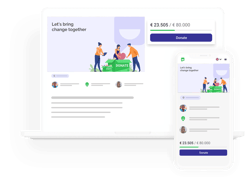Table of Contents
What Is Fundraising Charity?
Through charity fundraising, one can raise money for various charitable organizations and causes. They can organise events and develop effective fundraising strategies. These can include holding fundraising events and developing outreach programs. Nonprofit groups can also benefit from the work of these individuals.
Much has been written about charity fundraising online guide circles over the years. The sheer amount of tips and guidelines isn’t surprising since non-profits naturally rely on fundraising to fulfil their mission and keep their doors open. Hence, this manual, ‘Raising money for a good cause’ describes more about fundraising charity. There are many types of fundraising, and there is no one-size-fits-all approach. Every non-profit organisation is different. In the article below, we’ll discuss different types of fundraising, share some pros and cons of each type of fundraising, and discuss all about raising money for charity.
Before You Start Raising Money For Charity
-
Gain Donor Insights
When you understand your donors and know what’s important to them, you can connect with them in a meaningful and relevant way. If you find it easy, create donor profiles or donor personas to visualise your typical supporters. A donor persona represents a typical donor that includes their demographic information, goals, passions, and preferred communication style.
Think about your donors’ vehicle thinking about fundraising charity. Where are they located? What is their average age? What is the best way to reach them? How would they like to be addressed? What is their communication style? What do they really think is essential? What drives and motivates them?
-
Group Your Donors
Organising the donors is the process of categorising donors based on characteristics such as demographics and interests. Depending on the mission and size of your non-profit, you can categorise your donors. For example, you can categorise your donors by how they were recruited, their donations, level of engagement, frequency of giving, and more.
-
Set Goals
To successfully have a fundraising charity, your non-profit must set donor acquisition goals. An excellent first step is to collect data from the past five years and review your past fundraising results. In addition, review your organisation’s goals for the coming years, as well as any mission statements and visions. Gain insight into how much money you need to get closer to your mission this year and balance that with past achievements. Make sure to set a timeline for these goals as well.
Types Of Fundraising
With Advantages and Disadvantages
1. Direct Mail Fundraising
Donations for fundraising charity by direct mail are usually made in the form of checks. Donors who use this method tend to be older and prefer a more traditional way of giving. It’s helpful to know that there are still donors who feel more comfortable sending in a check than making a donation online. Direct mail can be used by anyone as long as you make sure to include an addressed envelope.
Advantages of Direct mail
Direct mail allows non-profits to reach donor segments that, for example, online fundraising doesn’t reach. If your non-profit has a group of older donors, it is possible that fundraising through the mail is very effective. This method of fundraising charity is also beneficial for local non-profits with a strong bond with their community.
Compared to some forms of online fundraising, direct mail also offers much more space to work; hence you can provide your donors with much more information. Direct mail offers you the chance to provide your donors with in-depth information that cannot be conveyed in a text message, Tweet, Facebook charity fundraising ad, or email.
Disadvantages of Direct mail
Direct mail can be expensive, especially compared to e-mail marketing. Direct mail is also time-consuming. You need to write letters, customise the list, delete comments, track people from your list, keep addresses up to date etc.
Sending mail isn’t quite the same impact it once had, as many donors throw their mail aside after a quick glance. To attract attention, you need to stand out and to stand out, and you need money (for example, hiring a graphic designer to design a captivating postcard).

2. Fundraising For Charity Events
Raising money for charity through fundraising events is becoming increasingly popular in the non-profit community. Whether a non-profit is hosting a charity walk, gala dinner, art exhibit, concert, or field day, event hosting is where donors and potential donors can interact personally and learn more about the organisation. Donations from charity fundraising events are contributions that donors raise during a fundraiser. Depending on the type of event, the money raised can come in different forms.
Advantages of charity events
Donors are more likely to give if they can associate names with faces. Because fundraising charity events are generally perceived as fun, they usually attract many people. Events also help increase an organisation’s visibility and brand. They help build the mailing list and can encourage online fundraising.
Fundraising charity events help build donor camaraderie, help organisations meet their donors, amaze new potential donors, and deepen their relationships with key donors.
Disadvantages of charity events
Events are usually labour-intensive and require a lot of detailed planning. An event can also be ruined because of the weather, a competing event on the same day, a guest who doesn’t show up, and many other details that you have little control over.
3. Online Donations
“Online donations” here refer to a dedicated donation page on your website.
SSIR learned from their data analysis that individual donors’ money from giving online grew from 17% to 24% in just two years. This means that approximately one dollar of every four dollars is generated online.
Therefore, for fundraising charity, if you want to recruit online donors in addition to an online donation platform, a donation page is the most important thing you should invest in. Make sure the experience a prospect gets on your website is user-friendly and smooth.
Advantages of Online Donations
The barrier to entry is low. It is very easy to set up a fundraising platform as well as Facebook, Instagram, and Twitter accounts to drive traffic to your website.
Raising money for charity via online financing has reached a much broader market than conventional direct mail or in-person recruiting while providing an almost instant cash flow. Done right, an online fundraiser is also simple and easy for donors. Giving online is faster and more convenient. A donor doesn’t have to sit down, write a check and mail it. They can enter their information and click a button. Online fundraising reduces costs over mail and in-person fundraising for organisations.
Analytics tools allow you to view stats, data, and details to quickly understand how the fundraising charity campaign is performing.
Disadvantages Of Online Donations
The proliferation of online fundraising charity campaigns and donation requests can lead to ‘donor fatigue’. The fees for online fundraising platforms and payment processing fees can add up quickly.
In addition, online fundraising charity campaigns for charity should try their best to be imaginative, compelling, and goal-oriented. Finally, regardless of which platform is used to direct donors to your donation page, having a large, robust and engaged audience online is absolutely crucial to make your fundraising successful. Managing and creating great content, building your reputation, and your online/social media presence can take months if not years. Finally, because organisations want to save time and money by encouraging online giving, they may inadvertently recruit donors who give less.
4. Door-to-door Fundraising
Door-to-door fundraising has declined over the years due to its penalized labour-intensive nature. However, this type of fundraising and fundraising is still used successfully by many organisations, especially political ones. Door-to-door fundraising generally works best for campaigns or programs that directly affect the individuals approached.
Advantages of Door-to-door Fundraising
Door-to-door campaigns can be very well aligned in terms of the target group, resulting in less downtime for the donors. Going door-to-door allows one-on-one interaction with potential donors/members who are unreachable via direct mail, email, and the Internet.
Disadvantages of Door-to-door Fundraising
Door-to-door fundraising is one of the main reasons people have a terrible impression of non-profit organisations. Some donors experience door-to-door recruitment as intrusive. Constant door-to-door recruiting is also quite labour-intensive and requires paid, full-time employees or highly enthusiastic and well-trained volunteers (which is again hard to achieve).
5. Calling For Charity Fundraising Requests
Over the years, raising money for charity through telephones has been used by many organisations with varying degrees of success. Phone requests are donation requests made over the phone, ranging from an employee making a few “thank you” calls to large telemarketing campaigns. Call people who are likely to give you a positive answer. The more people who know you and are already involved or invested with you, the greater your chance of success in fundraising.
Benefits
You can make phone calls for charity as personal as you want. If done right, the donors will feel valued and respected. In the case of telephone inquiries, the donations are often large.
Telephone requests can support any other type of fundraising and can increase the response to direct mail. It is scalable because the numbers can grow over time. Calling donors can increase a fundraiser’s current donor base and increase the size of donations, re-enrol donors, improve retention, convert donors to monthly donors, and are the perfect way to thank and generate donor feedback.
Cons
Phone calls for fundraising for charity are very labour-intensive. The fundraiser must also be well-prepared, skilled at fundraising, enthusiastic about the organisation, and willing to ask the question. Some donors are not happy with telephone requests. Therefore, if fundraisers using telephone inquiries are not tactful and competent, they can do more harm than good.
Finally, not everyone who promises money on the phone will actually donate.
6. E-mail Marketing For Charity Fundraising
Email marketing has sometimes been penalized for appearing to be old-fashioned, but many studies have shown that email marketing is the most effective way for non-profits to build awareness, acquire leads, raise funds, and retain current donors.
Advantages of E-mail Marketing for Charity Fundraising
Email marketing services are generally free to smaller non-profits. And even as the email list grows, charity email marketing continues to be very cost-effective. Emails are also easy to send. Email marketing tools have also become very intuitive with professionally designed templates, paste-and-cut functions, and other easy-to-use editors, and one does not need to know any coding to use them.
Compared to other forms of fundraising, email marketing recruits customers, members, donors, and volunteers faster. Emails can also be easily customised/personalised, and it is very easy to track their effectiveness.
Disadvantages of E-mail Marketing for Charity Fundraising
We are inundated with dozens of emails every day, including those about fundraising and advocacy and charity fundraising. Therefore, even as the number of subscribers grows, engagement sometimes declines. This means organisations need to become increasingly skilled at capturing the attention of their readers and the ways they use them to raise money for charity.
7. Donate Via SMS
Text donations are donations that donors can make via their mobile phones. Usually, donors have to text a certain word and/or amount to a unique number. They usually send the link to the organisation’s mobile-responsive donation page. Once a donor enters their details on this form, they never have to enter them again. There are also charity fundraising platforms that don’t require you to fill out a form (donors can confirm the donation by just texting “yes” back).
Advantages of Donate via SMS
Donating by SMS is easy and convenient. Almost everybody uses smartphones on a daily basis. Donations by SMS are somewhat like impulse purchases. They imply little to no research on the part of the donor, meaning that non-profits don’t have to hold the donors’ attention for very long. The speed and simplicity of this type of fundraising make it easy for donors to move through the process, making them less likely to leave the process.
Disadvantages of Donate via SMS
The costs for software, license costs and transaction costs can possibly amount to 5-10% of the total donations received. It can also sometimes take a while before an organisation receives the money. There is no built-in option for recurring gifts. In addition, there is often a limit on all donations. Some providers will only process donations from as little as €5 to €10.
There is no donor data collection system to help you build on the relationships initiated by sending a text message. With SMS donating, the organisation usually only has an anonymous phone number and the donation.
8. Crowdfunding For Charity
With crowdfunding, many people give a (usually) small donation of $5, $10, $50, $100 each. It has become a popular type of fundraising among corporate and non-profit organisations alike.
To get the most out of donation-based crowdfunding, you need to post regular updates, use compelling images and videos, offer incentives, and share information via email and social media. Make sure you tell a story because a story is what fuels a crowdfunding campaign.
Advantages of Crowdfunding
Raising money for charity through crowdfunding often helps an organisation promote its charity and brand fundraising campaign. It can help to identify a non-profit organisation to potential donors who would otherwise not have known about the organisation. Crowdfunding allows organisations to use many small donations to raise a larger total amount. Also, compared to traditional fundraising, much less time and money go into generating donations and connecting with donors.
Disadvantages of Crowdfunding
If an organisation does not yet have a large audience, it can take a significant amount of time to market the campaign. It requires ongoing communication with donors as well as sharing updates on progress along with major and minor setbacks. Crowdfunding is also very time-consuming if not done right.

9. Partnerships/Charity Sponsorship/Grants
Partnerships have always been an important part of non-profit fundraising. Between matching gift programs, grants, and sponsorships, large donations can come from companies that partner with non-profits. And the relationship is beneficial to both. Non-profits benefit from the resources businesses have to offer, and businesses benefit from being associated with a good cause.
Advantages of Charity Sponsorship
Grants, sponsorships and donations can often generate unbelievable sums of money. This allows for the execution of large projects that other types of fundraising probably could not have financed. A single grant can secure the near future of your non-profits.
Moreover, a partnership with like-minded organisations can increase your brand awareness.
Disadvantages of Charity Sponsorship
Sometimes organisations providing grants can be difficult to deal with due to their inherent bureaucratic nature. This type of fundraising may require you to invest a lot of time and energy. For example, it takes time to develop a winning writing skill or write a successful application, and then it can also take time to access those funds.
Some organisations find this type of fundraising too cumbersome and restrictive, as grants and sponsorship often come with all kinds of conditions. These terms apply to things like how exactly to use the money, as well as charitable fundraising-specific reporting requirements.
10. Peer-to-peer fundraising
Peer-to-peer fundraising is a crowdfunding method that uses an organisation’s existing networks. These fundraisers encourage donors to reach out to their peers (friends, colleagues, and relatives) and ask them to donate as well.
With peer-to-peer fundraising, individual fundraisers set up charity fundraising pages where they accept donations. On these pages, fundraisers give their own voice to the non-profit’s mission and share with their networks why that particular cause is important to them. These donations are ultimately received by the non-profit.
Advantages of Peer-to-peer Fundraising
Peer-to-peer fundraising allows non-profits to reach different groups of donors who would otherwise likely be inaccessible.
It is an efficient donor acquisition strategy as it leverages existing donor bases and their networks. It is also cost-effective because donors raise money on behalf of the organisation.
Peer-to-peer fundraising helps build social proof. We will be more likely to trust the recommendations of friends or relatives. This can help non-profits acquire more donors and acquire them much faster as well.
Disadvantages of Peer-to-peer Fundraising
One of the biggest drawbacks of peer-to-peer fundraising is the effort it takes to train existing donors/fundraisers. Not only do they need to know how to use the fundraising platform, but they also need to know how to raise funds effectively, even if they are raising through their personal networks. It can also be a challenge to clearly articulate the non-profit’s mission, vision, and values and convey them to dozens of individuals so they can continue to share them in the same way.
And then there’s the time it takes to address concerns or questions and inspire and motivate the fundraisers to go out and ask for donations.

What Is Left To Do Next?
-
Build Donor Relationship
Building donor relationships is the foundation of donor retention, no matter what type(s) of fundraising you choose.
Do your best to understand your donor’s perspectives. Becoming a donor-oriented organisation is a critical step that your non-profit organisation must take to drive fundraising and raise money for charity.
-
Measure And Evaluate
It is incredibly important to measure and evaluate the success of your fundraising strategies and activities. As you decide on different types of fundraising and strategies to put into practice, you create metrics (KPIs) related to your goals. These metrics should be key indicators of goal achievement and can be quantitative, qualitative, or both.
Based on the timeline you created when you created your goals, you consistently measure and evaluate your progress. By doing this, you’ll know if your fundraising strategies are the right ones (considering your goals).
Conclusion
The fundraising process can be very challenging, especially when the pressure is high, and the deadlines are strict and require a variety of methods and unrelenting hard work from non-profits to be successful in raising money for charity.
With so many different types of raising money for charity available, it becomes even more challenging to discern the right fundraising strategy and funding model. While opinions differ on the “ideal” non-profit funding model, using different fundraising types is generally good practice. However, finding the best method for you will not be without a struggle! Remember that to recruit and retain donors online, you need to ensure that their donations are processed smoothly and efficiently. So don’t forget to implement a donation management system!
To learn more about fundraising, visit the WhyDonate Blog section for more tips and resources.


















